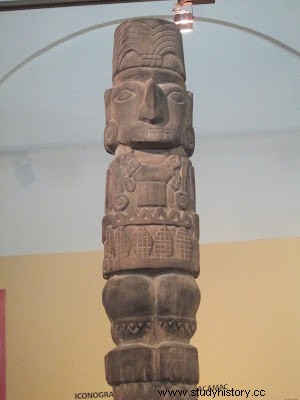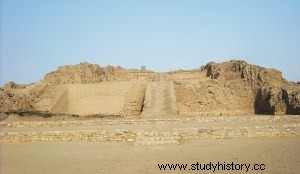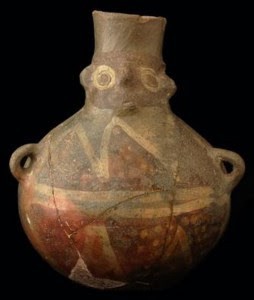
This deity was very famous and feared, he received offerings, human sacrifices and pilgrims who came from the confines of the Andean world. In the fifteenth century the Inca Empire peacefully annexed the Ishma kingdom, but respected the cult of the god Pachacámac, whose temple continued to be the oracle most famous of ancient Peru; however, in 1533 the Spanish arrived, led by Hernando Pizarro and Miguel de Estete, who looted it and largely destroyed it.
ETYMOLOGY
Ichma (or Ychsma, which according to Maria Rostworowski is the correct way of pronunciation) was the original name of the divinity worshiped in Pachacámac, in the language of the people of the Peruvian coast or yunga; Pachacámac is a compound word of Quechua origin, which was imposed by the Incas, and which means the maker of the world. According to one interpretation, the word ichma also designated the dye extracted from the achiote (Bixa orellana), which gives it a reddish hue.
According to Antonio de la Calancha , ichma was synonymous with llimpi, a name applied to quicksilver and its vermilion color, used as makeup in various rituals that the chronicler describes as sorcery. In either case, it is clear that this color had a special religious significance for the ichmas. The walls of the Pachacámac temples were painted that color.
GEOGRAPHICAL LOCATION
The Ichma Lordship encompassed the middle and lower valleys of the Lurín and Rímac rivers, on the central coast of what is now the province of Lima, in part of the territory where the Lima culture once flourished. Indeed, the ethnohistorical sources speak of an Ichma ethnic group that dominated these valleys until the Inca period; however, the available archaeological data shows diverse styles in ceramics and varied expressions in architecture, so we must assume that the term Ichma actually grouped together several curacazgos. They had different characteristics. There are those who maintain that from the south, the ichmas reached the Mala Valley. However, the boundaries of the ichma state have not yet been defined.
THE CAPITAL
All this political complex had Pachacámac as its center, and by then an ancient administrative-ceremonial center, which was greatly expanded with the construction of the so-called adobe pyramids with ramps. This sanctuary was the seat of a divinity highly revered for its oracle, whose prestige overflowed the limits of the ichma lordship. The inhabitants of the coastal valleys and even those of the mountains went there on a pilgrimage to consult the god. The idol of the god was carved in wood and kept in a small chamber. Its prestige would be maintained throughout the Inca period, lasting until the Spanish conquest.
MAIN CENTERS
- In the Lurín Valley: Pachacámac, the main ceremonial center. Other towns:Maracuyá, Pampa de Flores, Jacinto Grande, MalPaso, Molle, Manchay Alto, Huaycán, Chontay and Avillay.
- In the Rímac Valley: Armatambo; Maranga (in the sector called the citadel of tapia, where the huacas of Tres Palos, Cruz Blanca, San Miguel, La Cruz, La Palma stand out); Mateo Salado; mango brand; Campoy Fortress; Huaca Huantille; Huaca San Borja, among others.

POLITICAL ORGANIZATION
The Lordship of Ichma dominated various curacazgos located in the valleys of Lurín and Rímac. Said curacazgos were those of Sulco (Surco), Guatca, Lima, Maranca (Maranga) and Callao. They would form a kind of confederation, although there is not enough information about it.
SOCIAL ORGANIZATION
Like other manors of the central Peruvian coast, the mass of the population would be divided according to their specialization:fishermen, farmers, merchants, artisans. At the top of the social pyramid were, obviously, the lords or nobles who made up the ruling class.
ECONOMIC ORGANIZATION
The main economic activities were agriculture, fishing and the trade of surplus products. They took advantage of and improved the excellent network of canals or ditches inherited from the Lima culture, with which they gained extensive areas for cultivation. The valley of Lima was very fertile and provided subsistence for a large population. The great ceremonial precincts, in addition to their religious function, served as large warehouses for food products and as manufacturing centers for luxury goods.
HISTORICAL CONTEXT
Around 900 AD. the Huari Empire entered into frank decline. In its place, regional cultural expressions arose, inaugurating a new stage in Andean history. In the valleys of Lurín and Rímac, in the current department of Lima, the so-called Señorío ichma or Ichimay arises. The large towns of the previous era, located in areas far from the coast (such as Cajamarquilla), were abandoned to give prominence to new settlements more linked to the coast, such as Pachacámac and Armatambo. Maranga, the former capital of the Lima culture, also became important again, with a complex of pyramids rising to the south of the old settlement.
To the north of the ichma lordship extended the lordship of Collique which dominated the Chillón valley and the Carabayllo area and reached as far as Quivi (present-day Quives). It is possible that an alliance was forged between both lordships to contain the constant invasions of ethnic groups from the sierra, such as the yauyos and chacllas. The truth is that around 1470 A.D. the irruption of the Incas took place, supposedly under the command of Prince Túpac Yupanqui (the Sapa Inca was then Pachacútec), who annexed the entire region to the orbit of Tahuantinsuyo. However, the local authorities remained, after swearing obedience to the Inca of Cusco, and the Pachacámac sanctuary maintained its prestige and importance, being enlarged by the Incas themselves, although they imposed their own architectural style, raising a temple of the Sun and an Acllahuasi.
The population of the Lordship of Ichma must have been very large; More than 150,000 people must have lived in the lower Rímac valley alone, because according to the chronicles, the Incas organized the region into three Huns; each Hun included ten thousand families, according to the meticulous Inca decimal organization.
ART
Architecture
Pachacámac pyramid with ramp, typical of the Ichma culture. Important architectural expressions of the Ichmas are their truncated pyramids built with adobe bricks, although some are supported by a stone base. In all of them a common religious pattern is distinguished. These monuments basically have two characteristics:
- The massive use of rammed earth, that is to say, of large adobes or adobones of rammed clay, leaving aside the previous technique of small adobes or adobitos typical of the Lima culture.
- The presence of large access ramps.

15 temples with ramps have been identified at the Pachacámac site. In Maranga, located in the Lima Valley, the pyramids or huacas of La Palma and Tres Palos stand out. The pyramid with ramp of Huaquerones also seems to follow the same pattern. These constructions not only fulfilled ceremonial or religious functions, but also served as a warehouse for food products (corn, chili, etc.) and as accommodation for the artisans who produced ceramic pieces and wood carvings. , activities carried out in the sectors adjacent to the pyramids. After the Inca conquest, the truncated pyramids with ramps fell into disuse and the constructive style of the conquerors was imposed.
Ceramic
Ichma constructions are associated with ceramics with their own iconography, which has been little studied by researchers. «Typical Ichma ceramics are thick-paste and light red in color, sometimes decorated with black-white and white-red combinations, with a sculptural ornament called “caragollete”, that is, a stylized face decorating the neck of the vessel. Motifs with anthropomorphic, ornithomorphic, ichthyomorphic and zoomorphic figures are included.»

READ:"The hidden treasures of Huaca Bellavista "
Archaeological work in Huaca Bellavista, in Santa Anita, reveals burials of characters from the elite of the pre-Hispanic Ichma culture, vestiges of the Inca occupation and remains of Chinese from the 20th century. The district of Santa Anita has been founded for 28 years . However, evidence of continued occupation of the area dates back several centuries.
This is how archaeologist Roxana Gómez explains to the Official Gazette El Peruano the importance of the work to enhance the value of the Huaca Bellavista, the most important of the Ichma culture in this area. According to the specialist, director of the pre-Hispanic site recovery project, the The main objective is for the residents of the huaca to know the history of their locality. During the archaeological work, a series of objects have been discovered that reveal the multiple facets that this space played over time. EntierrosGómez says that several burials from the Ichma period have been found. Some of the bodies were children. Due to the funerary trousseau –jewels with spondylus applications, delicate pieces of fabric, ceramics–, the archaeologist assumes that the majority belonged to the elite. Another detail that Gómez reveals is that objects belonging to the Inca occupation were also found at the site, such as aríbalos .

The archaeologist states that the complex had a religious-administrative purpose. She also points out that from there the intake of the Surco canal is controlled, and it is close to the Late canal, so it has a strategic location. The archaeologist says that this huaca was abandoned in the time of Viceroy Toledo. However, it did have occasional uses. For example, at the beginning of the 20th century, the Chinese workers who could not be buried in the cemetery because they were not Christians were buried in the huacas. Up to seven of these burials have been found in the upper part of this complex.
SOURCE:andina.com
